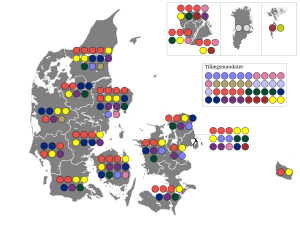1973 Danish general election
| ||||||||||||||||||||||||||||||||||||||||||||||||||||||||||||||||||||||||||||||||||||||||||||||||||||||
All 179 seats in the Folketing 90 seats needed for a majority | ||||||||||||||||||||||||||||||||||||||||||||||||||||||||||||||||||||||||||||||||||||||||||||||||||||||
| Turnout | 88.32% | |||||||||||||||||||||||||||||||||||||||||||||||||||||||||||||||||||||||||||||||||||||||||||||||||||||
|---|---|---|---|---|---|---|---|---|---|---|---|---|---|---|---|---|---|---|---|---|---|---|---|---|---|---|---|---|---|---|---|---|---|---|---|---|---|---|---|---|---|---|---|---|---|---|---|---|---|---|---|---|---|---|---|---|---|---|---|---|---|---|---|---|---|---|---|---|---|---|---|---|---|---|---|---|---|---|---|---|---|---|---|---|---|---|---|---|---|---|---|---|---|---|---|---|---|---|---|---|---|---|
This lists parties that won seats. See the complete results below.
| ||||||||||||||||||||||||||||||||||||||||||||||||||||||||||||||||||||||||||||||||||||||||||||||||||||||

General elections were held in Denmark on 4 December 1973 and in the Faroe Islands on 13 December.[1][2] It has since been referred to as the Landslide Election (Danish: Jordskredsvalget),[3] as five new or previously unrepresented parties won seats, and more than half the members of the parliament were replaced. The Social Democratic Party, which had led a minority government until this election, lost a third of their seats. After the election Poul Hartling, the leader of the liberal Venstre, formed the smallest minority government in Denmark's history with only 22 seats, supported by the Progress Party, the Conservative People's Party, the Social Liberal Party, the Centre Democrats and the Christian People's Party.
Voter turnout was 89% in Denmark proper, 55% in the Faroe Islands and 66% in Greenland.[4]
Parties
Two parties, the Christian People's Party and the Progress Party, campaigned against a grant awarded by the government-run Danish Film Institute for The Many Faces of Jesus, a proposed pornographic film about Jesus.[5]
The USSR covertly funded the Communist Party of Denmark.[6]
Results
 | |||||
|---|---|---|---|---|---|
| Party | Votes | % | Seats | +/– | |
| Denmark proper | |||||
| Social Democrats | 783,145 | 25.65 | 46 | –24 | |
| Progress Party | 485,289 | 15.89 | 28 | New | |
| Venstre | 374,283 | 12.26 | 22 | –8 | |
| Danish Social Liberal Party | 343,117 | 11.24 | 20 | –7 | |
| Conservative People's Party | 279,391 | 9.15 | 16 | –15 | |
| Centre Democrats | 236,784 | 7.76 | 14 | New | |
| Socialist People's Party | 183,522 | 6.01 | 11 | –6 | |
| Christian People's Party | 123,573 | 4.05 | 7 | +7 | |
| Communist Party of Denmark | 110,715 | 3.63 | 6 | +6 | |
| Justice Party of Denmark | 87,904 | 2.88 | 5 | +5 | |
| Left Socialists | 44,843 | 1.47 | 0 | 0 | |
| Independents | 637 | 0.02 | 0 | 0 | |
| Total | 3,053,203 | 100.00 | 175 | 0 | |
| Valid votes | 3,053,203 | 99.44 | |||
| Invalid/blank votes | 17,050 | 0.56 | |||
| Total votes | 3,070,253 | 100.00 | |||
| Registered voters/turnout | 3,460,737 | 88.72 | |||
| Faroe Islands | |||||
| Social Democratic Party | 3,772 | 28.60 | 1 | 0 | |
| Republican Party | 3,312 | 25.11 | 1 | New | |
| People's Party | 2,690 | 20.39 | 0 | –1 | |
| Union Party | 2,533 | 19.20 | 0 | 0 | |
| Self-Government | 553 | 4.19 | 0 | 0 | |
| Progress Party | 258 | 1.96 | 0 | 0 | |
| Independents | 72 | 0.55 | 0 | 0 | |
| Total | 13,190 | 100.00 | 2 | 0 | |
| Valid votes | 13,190 | 99.64 | |||
| Invalid/blank votes | 47 | 0.36 | |||
| Total votes | 13,237 | 100.00 | |||
| Registered voters/turnout | 24,259 | 54.57 | |||
| Greenland | |||||
| Independents | 15,869 | 100.00 | 2 | 0 | |
| Total | 15,869 | 100.00 | 2 | 0 | |
| Valid votes | 15,869 | 96.87 | |||
| Invalid/blank votes | 512 | 3.13 | |||
| Total votes | 16,381 | 100.00 | |||
| Registered voters/turnout | 24,838 | 65.95 | |||
| Source: Nohlen & Stöver | |||||
See also
- The 2015 Danish general election was called Hofteskredsvalget in reference to the term Jordskredsvalget
- Landslide victory
- Political realignment
References
- ^ Dieter Nohlen & Philip Stöver (2010) Elections in Europe: A data handbook, p524 ISBN 978-3-8329-5609-7
- ^ Denmark Inter-Parliamentary Union
- ^ Jespersen, KJV A History of Denmark
- ^ Nohlen & Stöver, p544
- ^ Dean, Wayne (1989-12-02). "Danish Blue: The Jesus Sex Film Scandal". The Sydney Morning Herald. p. 79. Archived from the original on 2023-12-16. Retrieved 2024-01-24.
- ^ Levin, Dov H. (2016-09-19). "Partisan electoral interventions by the great powers: Introducing the PEIG Dataset". Conflict Management and Peace Science. 36 (1): 88–106. doi:10.1177/0738894216661190. ISSN 0738-8942. S2CID 157114479.


